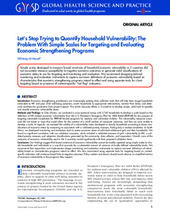Abstract
Introduction: Economic strengthening practitioners are increasingly seeking data collection tools that will help them target households vulnerable to HIV and poor child well-being outcomes, match households to appropriate interventions, monitor their status, and determine readiness for graduation from project support. This article discusses efforts in 3 countries to develop simple, valid tools to quantify and classify economic vulnerability status.
Methods and Findings: In Côte d'Ivoire, we conducted a cross-sectional survey with 3,749 households to develop a scale based on the definition of HIV-related economic vulnerability from the U.S. President's Emergency Plan for AIDS Relief (PEPFAR) for the purpose of targeting vulnerable households for PEPFAR-funded programs for orphans and vulnerable children. The vulnerability measures examined did not cluster in ways that would allow for the creation of a small number of composite measures, and thus we were unable to develop a scale. In Uganda, we assessed the validity of a vulnerability index developed to classify households according to donor classifications of economic status by measuring its association with a validated poverty measure, finding only a modest correlation. In South Africa, we developed monitoring and evaluation tools to assess economic status of individual adolescent girls and their households. We found no significant correlation with our validation measures, which included a validated measure of girls' vulnerability to HIV, a validated poverty measure, and subjective classifications generated by the community, data collector, and respondent. Overall, none of the measures of economic vulnerability used in the 3 countries varied significantly with their proposed validation items.
Conclusion: Our findings suggest that broad constructs of economic vulnerability cannot be readily captured using simple scales to classify households and individuals in a way that accounts for a substantial amount of variance at locally defined vulnerability levels. We recommend that researchers and implementers design monitoring and evaluation instruments to capture narrower definitions of vulnerability based on characteristics programs intend to affect. We also recommend using separate tools for targeting based on context-specific indicators with evidence-based links to negative outcomes. Policy makers and donors should avoid reliance on simplified metrics of economic vulnerability in the programs they support.

